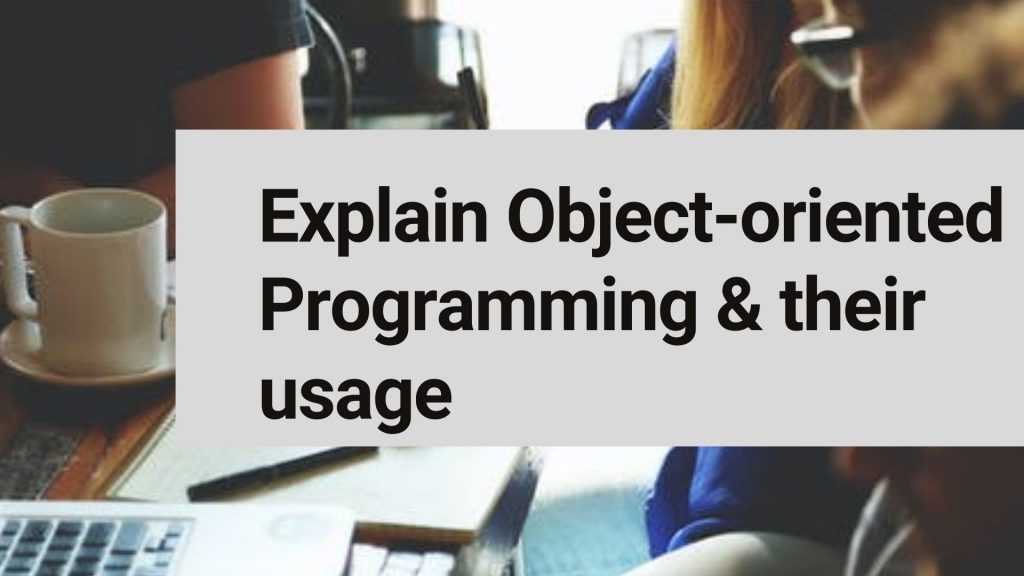Object-oriented programming (OOP) is a programming paradigm that organizes software design around data, rather than functions and logic. An object is a data field with its own set of properties and behavior. An object-oriented program’s structure also makes it useful for collaborative development, where projects are organized into groups. Code reusability, scalability, and efficiency are also advantages of OOP.
Object-Oriented Programming (OOP) stands for Object-Oriented Programming. As you would assume from the name, it breaks the program based on the objects it contains. It is primarily concerned with the concepts of class, object, polymorphism, abstraction, encapsulation, and inheritance. Its goal is to connect data and functions so that they can be used together.

What Is Object-Oriented Programming?
Object-oriented programming (OOP) focuses on the objects that developers desire to handle rather than the logic that is required to manipulate them. This kind of programming is ideally suited to big, complicated, and frequently updated or maintained projects. This encompasses manufacturing and design software, as well as mobile applications; for example, OOP may be used to simulate manufacturing systems.
Core OOPs Concepts:
Abstraction:
This notion entails hiding the program’s core details and making things simple to implement. Encapsulation and inheritance are two methods use in OOPs to accomplish this.
Encapsulation:
It is a technique use in object-oriented programming to provide abstraction. Encapsulation is a technique for limiting access to a class’s property or method. To achieve these access restrictions, we use access modifiers. There are three types of access modifiers: private, public, and protected.
Polymorphism:
In a class, we can specify multiple methods with the same name but varying types and numbers of variables they accept as inputs. Polymorphism is the concept of a thing behaving differently in different conditions. Compile-time polymorphism and runtime polymorphism are the two types of polymorphism.
Inheritance:
The inheritance encourages programmers to reuse code. This is the idea of defining a class that extends the attributes and methods of another class. This way, your new class inherits all of the properties of the class from which it is derive, and you can add additional properties and methods to it.
Benefits of Object-oriented Programming:

Moving on to the benefits of OOP, we’d like to point out that there are several, as this is one of the most extensively use development methodologies. Let’s take a look at the benefits that OOP provides to its users.
Redundancy of data:
This is a circumstance that occurs when the identical piece of data is store in two different places (you can call it a database). As a result, data redundancy is one of the most significant advantages of OOP. If a user requires similar functionality in several classes, he or she can write common class definitions for those functions and inherit them.
Advantages of Design:
If you practice OOPs, the design benefit a user will receive is in terms of designing and repairing things quickly, as well as eliminating risks (if any). Object-Oriented Programs force creators to go through a lengthy and thorough design phase, resulting in better designs and fewer faults. It’s easier to program all the non-one OOP’s by one when the program has reached some crucial boundaries.
Maintenance of the Code:
This feature is more of a must-have for any programming language; it saves users time and effort in a variety of ways. Maintaining and modifying current codes by adding new changes is always simple and time-saving.
Good Productivity:
Better productivity, as a result of the above-mentioned facts about utilizing the program, boosts the user’s total productivity. This results in more work being complete, better software being complete, more built-in features being available, and easier reading, writing, and maintenance. An OOP programmer can create whole new applications by stitching together new software elements. It’s feasible thanks to a large number of libraries with numerous useful functions.
Troubleshooting is simple:
So, many times, something goes wrong, and the developers have to do a lot of brainstorming to figure out where the problem is. Relax! You’ll know what to check for if you’re working with the OOP language. The benefit of encapsulation in OOP is that all objects are self-constrain. IT teams gain a lot of work benefits from this multimodal behavior because they can now work on numerous projects at the same time, with the added bonus of no code duplication.
Solving issues:
It’s a good idea to break down a difficult task into smaller chunks or discrete components. OOP is adept at this, as it breaks down your software code into manageable chunks – one object at a time. The broken components can either be reuse in future modules that relate to the same interface with implementation details, or they can be replace by future modules that relate to the same interface with implementation details.
Other Benefits:
- We can develop programs using standard operating modules that communicate with one another, saving time and enhancing productivity, rather than having to start creating code from scratch. The OOP language helps us to break down the program into manageable chunks that can be solve rapidly (one object at a time).
- The new technology is said to boost programmers’ productivity, improve software quality, and lower maintenance expenses.
- OOP systems can be easily upgrade from small to huge systems.
- Multiple instances of objects can survive without interfering with one another, therefore utilizing objects to divide labor in a project is relatively straightforward.
- The objects in the problem domain can be map to those in the program.
- The data concealing principle aids programmers in creating secure programs that are not vulnerable to code in other areas of the program.
- We can minimize duplicate code and increase the use of existing classes by using inheritance.
- For communication between objects, message passing mechanisms are utilize, which simplifies the interface specifications with external systems.
- We can capture more information of the model in an implementable form using the data-centered design technique.
Drawbacks:

The mental process needed in object-oriented programming is not natural for certain people, and it can take some time for them to change. It’s challenging to make programs that are dependent on object interaction. Some of the most important programming concepts, such as inheritance and polymorphism, are initially difficult to grasp. Object-oriented programs are typically larger and have more lines of code than procedural applications.
Slower-running programs include:
Because they need the execution of additional instructions, object-oriented applications are frequently slower than procedure-based systems.
Not appropriate for all types of issues:
There are some issues that lend themselves well to functional programming, logic programming, or procedure-based programming, and object-oriented programming will not produce efficient solutions in those instances.
Usage of Object-Oriented Programming:

Object-oriented programming (OOP) is a programming paradigm that focuses on objects and data instead of actions and reasoning. A conventional procedural program is set up to take inputs from the user, process it, and output a result. Rather than data, the program was built around logic. We focus on objects and their manipulation in object-oriented programming rather than the logic that does it. The OOPs programmer can use a variety of objects as examples, such as a car, a dog, a human, a building, and so on.
Client-Server Systems:
Object-oriented client-server systems create Object-Oriented Client-Server Internet (OCSI) applications by providing the IT infrastructure. The terms “infrastructure” and “operating systems,” respectively, refer to operating systems, networks, and hardware.
Databases that are Object-Oriented
Object Database Management Systems is another name for them (ODBMS). Objects such as real numbers and integers are store in these databases rather than data. The following are examples of objects:
Attributes are data that specify an object’s characteristics. Integers and real numbers are examples of basic data. It can also be a sophisticated object reference.
System Design in Real-Tim
Real-time systems have intrinsic complexity that makes their development difficult. Object-oriented approaches make dealing with these complications much easier. These methodologies provide a comprehensive framework that incorporates schedulability analysis and behavioral specifications to deal with these challenges.
System for Simulation and Modeling
The fluctuating specification of variables makes it challenging to model complicated systems. These are common in medicine as well as other natural science fields like ecology, zoology, and agronomic systems. Simulating complex systems necessitates explicit modeling and understanding of interactions. Object-oriented programming offers a different way to simplify these complicated modeling frameworks.
Hypertext and hypermedia:
OOP also aids in the creation of a hypertext framework. Hypertext is comparable to conventional text in that it can be readily store, searched, and changed. The only distinction is that hypertext is the text that also contains pointers to other content.
Hypertext is a subset of hypermedia, which is a superset of hypertext. Hypermedia documents not only contain links to other pieces of text and information, but also to a variety of other types of media, such as images and sound.
Parallel Programming and Neural Networking:
It deals with the problem of approximating and predicting complex time-varying systems. To begin, the time-varying process is divide into multiple time intervals or slots. Then, to distribute the load among the multiple networks, neural networks are form over a specific time frame. OOP streamlines the entire process by reducing the complexity of network approximation and prediction.
See also Virtual Reality and Augmented Reality and the future of Learning







